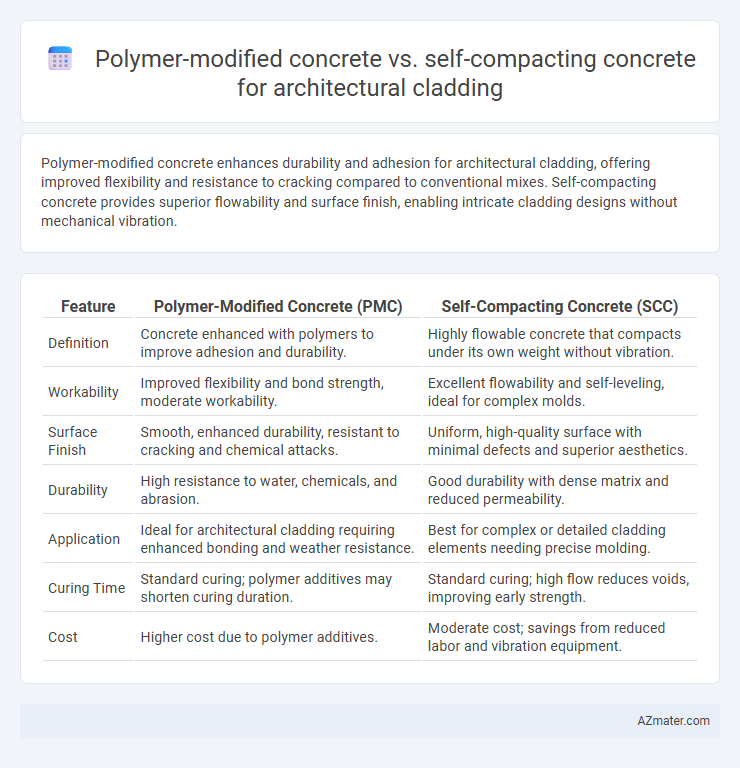Polymer-modified concrete enhances durability and adhesion for architectural cladding, offering improved flexibility and resistance to cracking compared to conventional mixes. Self-compacting concrete provides superior flowability and surface finish, enabling intricate cladding designs without mechanical vibration.
Table of Comparison
| Feature | Polymer-Modified Concrete (PMC) | Self-Compacting Concrete (SCC) |
|---|---|---|
| Definition | Concrete enhanced with polymers to improve adhesion and durability. | Highly flowable concrete that compacts under its own weight without vibration. |
| Workability | Improved flexibility and bond strength, moderate workability. | Excellent flowability and self-leveling, ideal for complex molds. |
| Surface Finish | Smooth, enhanced durability, resistant to cracking and chemical attacks. | Uniform, high-quality surface with minimal defects and superior aesthetics. |
| Durability | High resistance to water, chemicals, and abrasion. | Good durability with dense matrix and reduced permeability. |
| Application | Ideal for architectural cladding requiring enhanced bonding and weather resistance. | Best for complex or detailed cladding elements needing precise molding. |
| Curing Time | Standard curing; polymer additives may shorten curing duration. | Standard curing; high flow reduces voids, improving early strength. |
| Cost | Higher cost due to polymer additives. | Moderate cost; savings from reduced labor and vibration equipment. |
Introduction: Advancements in Architectural Cladding
Polymer-modified concrete enhances architectural cladding with improved tensile strength, durability, and resistance to environmental factors, making it ideal for complex shapes and exposed facades. Self-compacting concrete offers superior workability and flowability, enabling intricate designs without the need for vibration, thus reducing labor costs and ensuring uniform surface finishes. Both materials represent significant advancements in architectural cladding by combining aesthetics with enhanced performance characteristics tailored to modern construction demands.
Overview of Polymer-Modified Concrete
Polymer-modified concrete (PMC) enhances traditional concrete by integrating polymer resins, significantly improving adhesion, flexibility, and water resistance, which are critical for architectural cladding applications. This modification reduces permeability and increases durability, making PMC ideal for facades exposed to harsh weather conditions and aggressive environments. Compared to self-compacting concrete, PMC offers superior surface finishing and better bonding properties that contribute to the aesthetic and structural performance of architectural cladding systems.
Understanding Self-Compacting Concrete
Self-compacting concrete (SCC) offers superior flowability and non-segregating properties, making it ideal for intricate architectural cladding with complex molds and detailed textures. Unlike polymer-modified concrete, SCC requires no mechanical vibration, reducing labor costs and ensuring high-quality surface finishes with minimal defects. Its optimized mix design, incorporating high-range water reducers and fine powders, enhances workability while maintaining structural integrity and durability critical for exterior cladding applications.
Key Material Properties Comparison
Polymer-modified concrete enhances tensile strength, adhesion, and durability through the incorporation of polymers, making it highly resistant to cracking and weathering in architectural cladding applications. Self-compacting concrete offers superior flowability and eliminates the need for vibration, ensuring better surface finish and uniformity essential for intricate cladding designs. The key material properties comparison reveals that polymer-modified concrete excels in mechanical performance and chemical resistance, while self-compacting concrete provides improved workability and aesthetic quality, influencing the choice based on project requirements.
Surface Finish and Aesthetic Potential
Polymer-modified concrete offers enhanced surface durability and color retention, providing architects with a smooth, glossy finish ideal for vibrant, long-lasting cladding. Self-compacting concrete enables intricate shapes and complex textures with high fluidity, allowing for seamless, detailed architectural panels without surface voids or honeycombing. Both materials optimize aesthetic potential, with polymer modifiers emphasizing surface resilience and self-compacting mixes prioritizing form precision and tactile quality.
Durability and Weather Resistance
Polymer-modified concrete enhances durability and weather resistance in architectural cladding by increasing adhesion, reducing permeability, and improving flexibility, which guards against cracking and chemical attack. Self-compacting concrete offers excellent surface finish and uniformity but typically requires additional admixtures to achieve comparable durability under harsh weather conditions. Long-term performance of polymer-modified concrete often surpasses self-compacting concrete in resisting freeze-thaw cycles, moisture ingress, and UV exposure, making it a preferred choice for resilient architectural cladding applications.
Workability and Placement Efficiency
Polymer-modified concrete enhances workability by improving adhesion and reducing segregation, making it ideal for intricate architectural cladding requiring precise placement. Self-compacting concrete offers superior placement efficiency through its high flowability and ability to fill complex molds without vibration, minimizing labor and time. Both materials optimize installation, but self-compacting concrete excels in seamless surface finishes, while polymer-modified concrete provides increased durability and bonding strength.
Design Flexibility and Customization
Polymer-modified concrete offers enhanced adhesion and durability, allowing architects to achieve intricate textures and vibrant finishes for architectural cladding with high design flexibility. Self-compacting concrete provides superior flowability and uniformity, enabling complex shapes and seamless surfaces without segregation, ideal for bespoke panel designs. Both materials support customization but differ in performance characteristics, where polymer modification excels in surface treatment and self-compacting concrete excels in form complexity.
Sustainability and Environmental Impact
Polymer-modified concrete enhances durability and reduces permeability, extending the lifespan of architectural cladding while minimizing maintenance and material waste. Self-compacting concrete promotes sustainability by eliminating the need for mechanical vibration, reducing noise pollution and labor energy consumption on construction sites. Both materials contribute to environmental impact reduction through improved performance, but self-compacting concrete offers superior workability and reduced carbon footprint in large-scale cladding applications.
Cost Implications for Cladding Applications
Polymer-modified concrete enhances durability and adhesion in architectural cladding but incurs higher material costs due to the inclusion of resins and additives. Self-compacting concrete reduces labor expenses and improves surface finish quality, potentially lowering overall installation costs despite slightly higher mix costs. Evaluating project scale and complexity is crucial to balancing initial material investment against long-term savings in labor and maintenance for cladding applications.

Infographic: Polymer-modified concrete vs Self-compacting concrete for Architectural cladding
 azmater.com
azmater.com